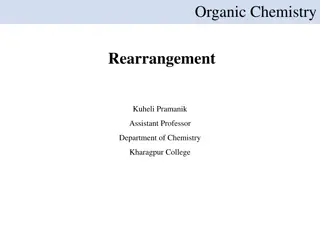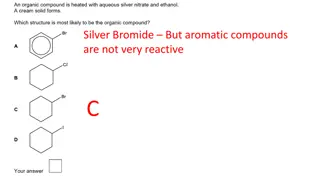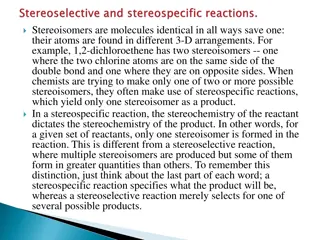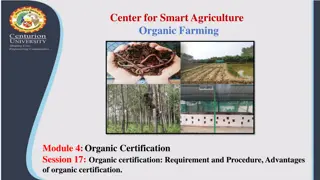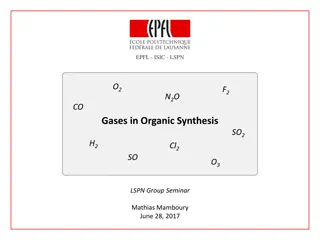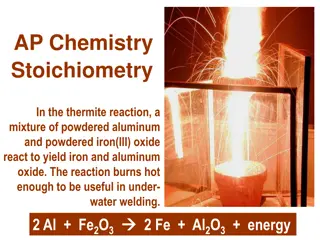Organic Chemistry Reactions Overview
This content covers various aspects of organic chemistry reactions, including the oxidation of alcohols with potassium dichromate, the solubility of molecules in water, and the oxidation of propan-1-ol to form aldehydes or carboxylic acids. It also explores the oxidation of butan-2-ol and the suitability of apparatus for oxidation reactions. The key points highlighted are the reactions, observations, products formed, and reaction conditions that control product formation.
Download Presentation

Please find below an Image/Link to download the presentation.
The content on the website is provided AS IS for your information and personal use only. It may not be sold, licensed, or shared on other websites without obtaining consent from the author. Download presentation by click this link. If you encounter any issues during the download, it is possible that the publisher has removed the file from their server.
E N D
Presentation Transcript
Which alcohol will not react with potassium dichromate(VI) in sulfuric acid? A. CH3CH2CH(OH)CH2CH3 B. CH3CH2CH(CH3)CH2OH C. (CH3)2CHCH(CH3)OH D. (CH3CH2)2C(CH3)OH D TERTIARY ALCHOLS CANNOT BE OXIDISED
Butan-1-ol is reacted with acidified potassium dichromate(VI) using the apparatus shown below. What is the organic product of this reaction? A. But-1-ene B. Butanone C. Butanal D. Butanoic acid C PRIMARY ALCHOLS GIVE ALDEHYDES WITH [O] + DISTILLATION
Which alcohol can be oxidised by K2Cr2O7 and H2SO4 to form a ketone? B SECONDARY ALCHOLS GIVE KETONES WITH [O]
Describe the oxidation reactions of propan-1-ol when using a suitable oxidising agent. Indicate how the use of different reaction conditions can control which organic product forms. Include reagents, observations and equations in your answer. In your equations, use structural formulae and use [O] to represent the oxidising agent. [6] Reagents: Acid / H+ and (potassium or sodium) dichromate / Cr2O72 Observations: Orange to Green OR Orange to Blue Distillation / Distil produces aldehyde / CH3CH2CHO: CH3CH2CH2OH + [O] CH3CH2CHO + H2O Reflux (of propan-1-ol) produces carboxylic acid / CH3CH2COOH CH3CH2CH2OH + 2[O] CH3CH2COOH + H2O
The OH group is attached to a carbon that is attached to one hydrogen atom OR The OH group is attached to a carbon that is attached to two C atoms / alkyl groups/R groups
Butan-2-ol can be oxidised by heating with an oxidising agent. i. Write an equation for the reaction. Use [O] to represent the oxidising agent and show the structure of the organic product. Equation CH3CH(OH)CH2CH3+ [O] CH3COCH2CH3 + H2O Structure of product could be allowed from equation CH3COCH2CH3
Butan-2-ol can be oxidised by heating with an oxidising agent. ii. A student plans to carry out this oxidation using the apparatus shown in the diagram. Give one reason why the apparatus is not suitable and describe a more suitable way of carrying out this oxidation. Butan-2-ol/butanone is flammable OR Butan-2-ol / butanone is volatile / low boiling point OR Butan-2-ol / butanone will evaporate / boil away






